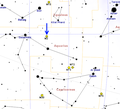Messier 2
| Messier 2 | |
|---|---|
 | |
| Observation data (J2000 epoch) | |
| Class | II[1] |
| Constellation | Aquarius |
| Right ascension | 21h 33m 27.02s[2] |
| Declination | –00° 49′ 23.7″[2] |
| Distance | 55,000 ly (17 kpc)[3] |
| Apparent magnitude (V) | +6.3[4] |
| Apparent dimensions (V) | 16′.0 |
| Physical characteristics | |
| Mass | 1.04×105[5] M☉ |
| Radius | 87.3 ly[6] |
| Metallicity | = –1.65[5] dex |
| Estimated age | 13 Gyr |
| Other designations | NGC 7089.[4] |
Messier 2 or M2 (also designated NGC 7089) is a globular cluster in the constellation Aquarius, five degrees north of the star Beta Aquarii. It was discovered by Jean-Dominique Maraldi in 1746, and is one of the largest known globular clusters.
Discovery and visibility
M2 was discovered by the French astronomer Jean-Dominique Maraldi in 1746 while observing a comet with Jacques Cassini. Charles Messier rediscovered it in 1760, but thought it a nebula without any stars associated with it. William Herschel, in 1783, was the first to resolve individual stars in the cluster.
M2 is, under extremely good conditions, just visible to the naked eye. Binoculars or a small telescope will identify this cluster as non-stellar, while larger telescopes will resolve individual stars, of which the brightest are of apparent magnitude 13.1.
Characteristics
M2 is about 55,000 light-years distant from Earth. At 175 light-years in diameter, it is one of the larger globular clusters known. The cluster is rich, compact, and significantly elliptical. It is 13 billion years old and one of the older globulars associated with the Milky Way Galaxy.
M2 contains about 150,000 stars, including 21 known variable stars. Its brightest stars are red and yellow giant stars. The overall spectral type is F4.[4] M2 is part of the Gaia Sausage, the hypothesised remains of a merged dwarf galaxy.[7]
Image gallery
-
M2 from 2MASS sky survey
-
Map showing location of M2
-
Messier 2 Globular Cluster imaged from Talent, OR.
References
- ^ Shapley, Harlow; Sawyer, Helen B. (August 1927), "A Classification of Globular Clusters", Harvard College Observatory Bulletin (849): 11–14, Bibcode:1927BHarO.849...11S.
- ^ a b Goldsbury, Ryan; et al. (December 2010), "The ACS Survey of Galactic Globular Clusters. X. New Determinations of Centers for 65 Clusters", The Astronomical Journal, 140 (6): 1830–1837, arXiv:1008.2755, Bibcode:2010AJ....140.1830G, doi:10.1088/0004-6256/140/6/1830.
- ^ Collaboration, Gaia; Helmi, A; van Leeuwen, F; McMillan, P. J; Massari, D; Antoja, T; Robin, A; Lindegren, L; Bastian, U; co-authors, 445 (2018). "Gaia Data Release 2: Kinematics of globular clusters and dwarf galaxies around the Milky Way". arXiv:1804.09381 [astro-ph.GA].
{{cite arXiv}}:|first10=has numeric name (help) - ^ a b c "M 2". SIMBAD. Centre de données astronomiques de Strasbourg. Retrieved 2006-11-15.
- ^ a b Boyles, J.; et al. (November 2011), "Young Radio Pulsars in Galactic Globular Clusters", The Astrophysical Journal, 742 (1): 51, arXiv:1108.4402, Bibcode:2011ApJ...742...51B, doi:10.1088/0004-637X/742/1/51.
- ^ distance × sin( diameter_angle / 2 ) = 87.3 ly. radius
- ^ Myeong, G. C; Evans, N. W; Belokurov, V; Sanders, J. L; Koposov, S. E (2018). "The Sausage Globular Clusters". arXiv:1805.00453 [astro-ph.GA].

![{\displaystyle {\begin{smallmatrix}\left[{\ce {Fe}}/{\ce {H}}\right]\end{smallmatrix}}}](https://wikimedia.org/api/rest_v1/media/math/render/svg/4c0821bd80891e071c08e7c7ee8e022baedf522c)



